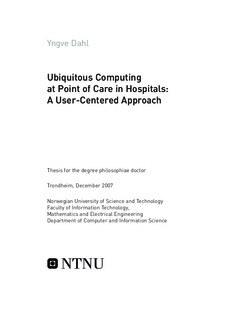| dc.contributor.author | Dahl, Yngve | nb_NO |
| dc.date.accessioned | 2014-12-19T13:30:09Z | |
| dc.date.available | 2014-12-19T13:30:09Z | |
| dc.date.created | 2008-01-11 | nb_NO |
| dc.date.issued | 2007 | nb_NO |
| dc.identifier | 123242 | nb_NO |
| dc.identifier.isbn | 978-82-471-3226-5( | nb_NO |
| dc.identifier.uri | http://hdl.handle.net/11250/249880 | |
| dc.description.abstract | Ubiquitous computing opens up for a wide range of ways to support human-computer interaction beyond the desktop, and promises more seamless integration between computer technology and situations of use. However, the dissemination of ubiquitous computing has been slow. Research on this type of technology has in many ways been technically motivated, rather than focusing on how it can be made practically useful. Most critical, there is little design guidance that can help technology developers apply ubiquitous computing designs and concepts to real-world use settings, and provide an understanding of how this technology presents itself to users.
This thesis addresses the applicability of ubiquitous computing in the highly dynamic work environment that hospitals form. The current work aims to inform user-centered design of ubiquitous computing solutions for hospital workers and care situations that occur at the patient’s bedside.
The conducted research has resulted in five journal and conference papers (see Part II) that address various aspects relevant for the different phases (analysis, design, and evaluation) of user-centered design.
In the first paper, requirements for design methods, context models, and system properties of mobile electronic patient charts are discussed. In particular, it shows how the proceeding of events occurring in the information system and the real world relative to specific user can be used as a basis for navigation in clinical information.
The second paper investigates the affordances of paper-based medication charts out of the motivation that this can help inform design of ubiquitous computing solutions for clinical use. It shows how paper as an information medium offers affordances (and constraints) central for clinical information work, many of which are not directly transferable to digital media.
The third paper proposes a visual formalism for describing human-computer interaction in digitally augmented spaces. The paper also describes and discusses results from an expert group evaluation of the formalism.
In the fourth paper, a usability comparison of different location and token-based interaction techniques for accessing medical information at the point of care is presented. The paper identifies three user-perceived usability issues relevant for implementation of sensor-based interaction techniques in hospital settings: required user attention, predictability of system behavior, and integration with work situation. It also shows that the interaction techniques differ in terms of the extent to which they fulfill the above criteria, and that the usability of the various techniques is highly relative to the immediate use situation.
Lastly, in the fifth paper the usability of a location-based communication service is evaluated. The service allows hospital workers to leave short digital messages at relevant physical locations (e.g., by a patient bed), so that colleagues can access them later when entering such a location. A usability evaluation of the service indicated that participants (nurses) valued its non-interruptive means of exchanging information, and that it potentially can reduce reliance on their personal memory, when used as a personal reminder service.
Taken together the papers form a platform for future research on UbiComp technology applied in hospital work. | nb_NO |
| dc.language | eng | nb_NO |
| dc.publisher | Fakultet for informasjonsteknologi, matematikk og elektroteknikk | nb_NO |
| dc.relation.ispartofseries | Doktoravhandlinger ved NTNU, 1503-8181; 2007:147 | nb_NO |
| dc.relation.haspart | Dahl, Yngve; Sørby, Inger Dybdahl; Nytrø, Øystein. Context in Care – Requirements for Mobile Context-Aware Patient Charts. Proceedings of the 11th world congress on medical informatics (MEDINFO): 597-601, 2004. | nb_NO |
| dc.relation.haspart | Dahl, Yngve; Svanæs, Dag; Nytrø, Øystein. Designing Pervasive Computing for Hospitals: Learning from the Media Affordances of Paper-Based Medication Charts. Pervasive Health Conference and Workshops: 1-10, 2006. | nb_NO |
| dc.relation.haspart | Dahl, Yngve. Toward a Visual Formalism for Modeling Location and Token-Based interaction in Context-Aware Environments. Proceedings of the Second IASTED International Conference on Human-Computer Interaction: 183-192, 2007. | nb_NO |
| dc.relation.haspart | Dahl, Yngve. You Have a Message Here”: Enhancing Interpersonal Communication in a Hospital Ward with Location-Based Virtual Notes. Methods of Information in Medicine. 45(6): 602-609, 2006. | nb_NO |
| dc.title | Ubiquitous Computing at Point of Care in Hospitals: A User-Centered Approach | nb_NO |
| dc.type | Doctoral thesis | nb_NO |
| dc.contributor.department | Norges teknisk-naturvitenskapelige universitet, Fakultet for informasjonsteknologi, matematikk og elektroteknikk, Institutt for datateknikk og informasjonsvitenskap | nb_NO |
| dc.description.degree | PhD i informasjons- og kommunikasjonsteknologi | nb_NO |
| dc.description.degree | PhD in Information and Communications Technology | en_GB |
